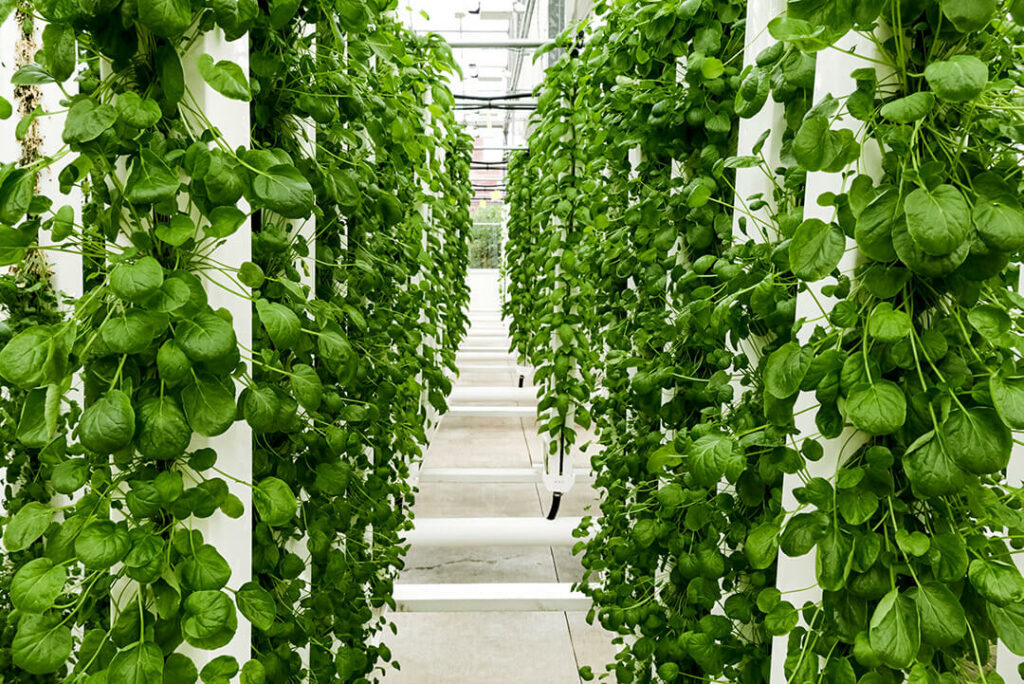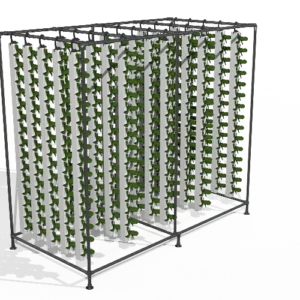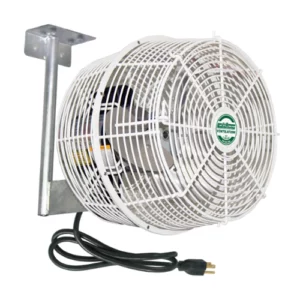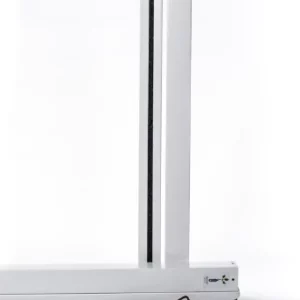As real estate prices continue to reach historic highs, Controlled Environment Agriculture (CEA) is emerging as a solution for landlocked urban and suburbanites.
This article will feature an entry-level greenhouse that can fit on a 1,000 ft2 footprint and can be operated as a part-time job.
We will take some time to understand which crops are appropriate, seasonal variations, and market pricing for several popular crops. Finally, we will take a look at the startup costs involved and the potential profits.
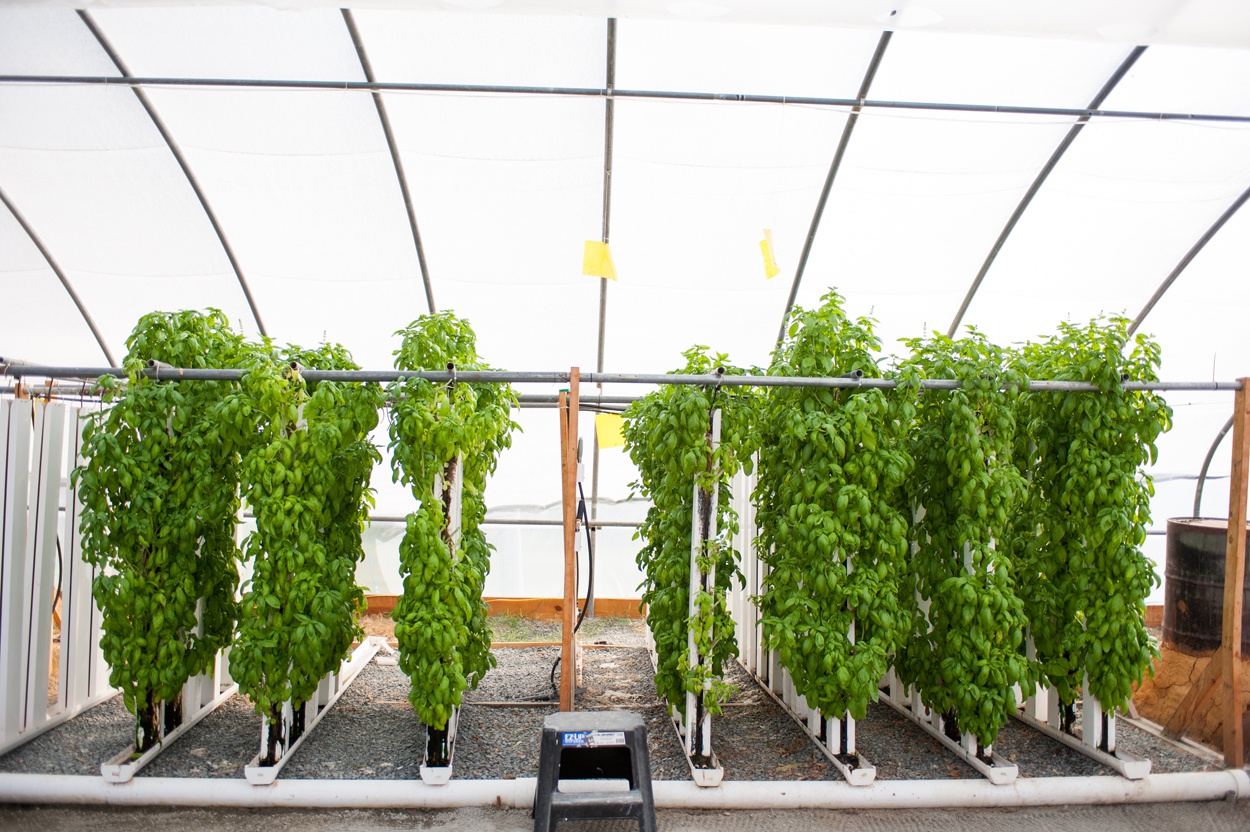
Why is this Important?
As farmlands disappear at an increasing rate, many suburban and urban farmers are turning to high-density CEA techniques to bring greenhouse businesses into the suburbs and, increasingly, into the urban core. The greenhouse shown here can be built for a total cost of about $35,000, including the costs to install new water and electric lines. This type of greenhouse can be used to add a line of business to an existing property or for first-time farmers who are thinking about growing for market.
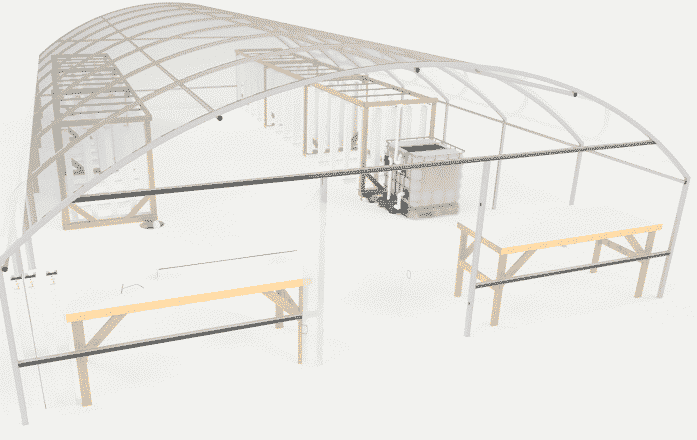
Because it is a relatively small structure, it can be operated in about 20 hours a week, including the time for harvesting, packaging and delivery to market. One of our farm partners is a couple in their 30s. Both have day jobs, and they are able to manage their farm on nights and weekends.
If you are thinking about starting a greenhouse business with hydroponic techniques…
You are probably familiar with the benefits of hydroponics.
- No weeding and little or no herbicides
- Simplified pest management
- Faster crop turns
- Higher density crop yields
- Depending on the application, resource use can be lowered dramatically (water, electricity, fuel).
The good news is that hydroponics has also gained more consumer trust in recent years. Scientific research shows that the crops taste just as good as organic ones, and that they are just as nutritious also.
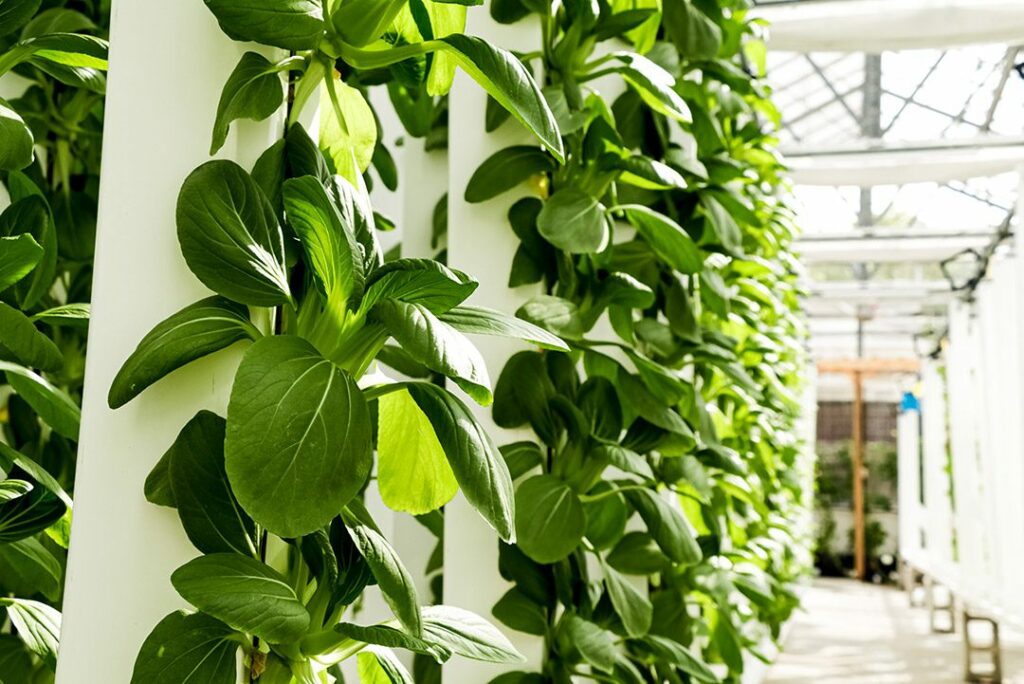
Crop Selection and Growing Season
In Controlled Environment Agriculture, the aim is to “provide protection and maintain optimal growing conditions throughout the development of the crop.” This is done by housing production inside an enclosed space (a greenhouse or building).
Many CEA operations focus on growing a few specific crops as consistently as possible throughout the year. The goal is to provide a steady supply for customers and – as much as possible – to avoid seasonal interruptions. For wholesale customers, having an uninterrupted supply is just easier and may be the difference in their purchase decision.
Although it is possible to grow several crops at the same time, CEA is focused carefully on economics, and often the best way to beat the market curve is to become very good at growing a few crops.
For growers interested in broadening their crop selection, you may choose to build a separate greenhouse for crops that require a different growing environment.
This could mean warm-weather herbs like basil or chives (with supplemental heating) from March through October. Or, it could mean cool weather herbs like mint and cilantro (with evaporative cooling) from March through October.
Recommended Crops
This article is focused on high water-weight crops that enjoy a rapid crop cycle. These are primarily leafy greens and herbs.
We chose to focus our study on two crops that grow well together: basil and chives. These crops require similar conditions in the greenhouse, and they are also some of the most profitable plants to grow hydroponically. The goal is to find a market for roughly 110 lbs a week for these herbs.
Finding the market can be a slow, time-consuming process. Some farmers will grow a secondary crop like mini heads of lettuce, which are popular and easier to sell, but bring a lower price. This approach gives the assurance of having more consistent sales while building sales capacity for higher-margin herbs.
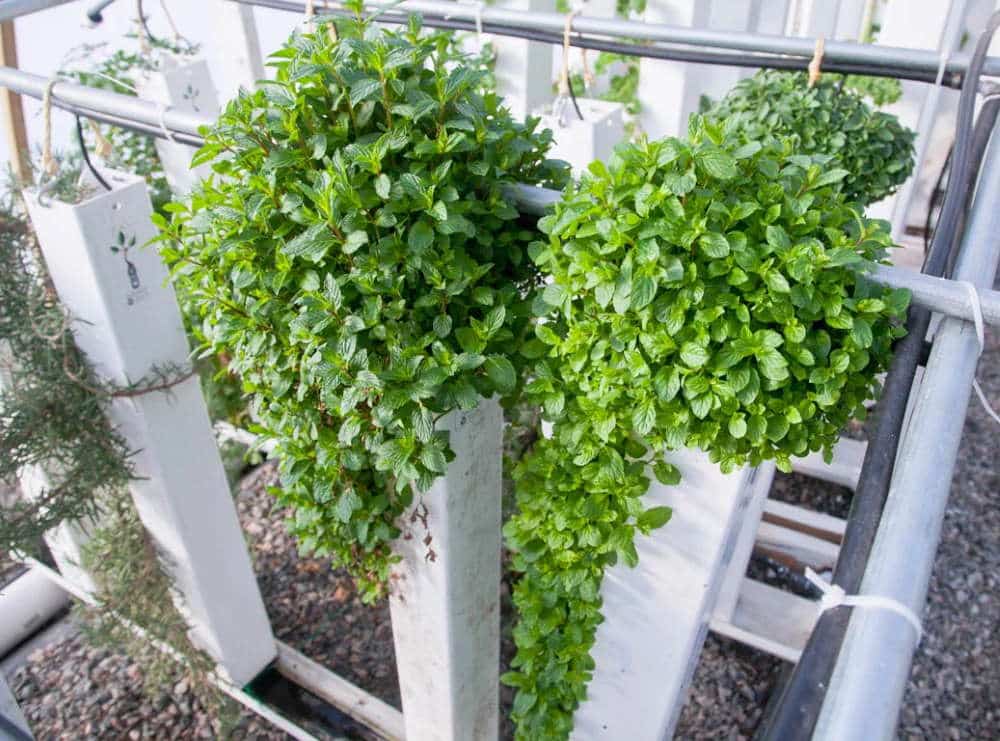
In a warmer greenhouse climate, you can test your market for oregano, lemongrass (popular in Thai and Vietnamese cuisine), Bok Choy, and others.
Cool weather crops will include arugula, kale, mustard greens, cilantro (coriander), tarragon, fennel, nasturtiums, and peppermint, among others.
While choosing an approach to CEA can be challenging, your customers will appreciate it. Many crops are in demand throughout the year, and to meet this demand your customers are turning to imported crops from California or Mexico. Greenhouse growers will have the opportunity to provide a local option for them.
How Much Can I Grow?
Verified Crop Yields in a Vertical Greenhouse
Study Background
In most northern climates, this greenhouse should be productive with natural sunlight for roughly 8 months out of the year. Southern regions will be able to enjoy a longer season but will also have to manage heat and humidity.
The crop yields provided here are based on several years of production testing, complete with peer oversight for a doctoral dissertation.
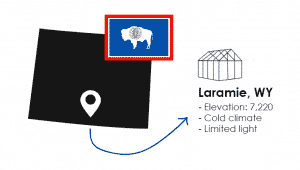
The testing was done using aquaponic techniques in hardiness zone 4b. The location was southeastern Wyoming, at an elevation of 7,200 feet. As you may guess, this is a climate that is cool and dry, with limited natural sunlight in the winter months.
Results
Hydroponic growing may result in increased yields from the ones shown here.
These are popular crops that also fetch a good price in the market. With some basic market research you may be able to find a strong demand with local food coops or restaurants.
| Herbs | Seed to Germination | Germination to Transplant | Transplant to Harvest | Yield per Tower per Turn |
| Genovese Basil | 7-10 days | 3-5 weeks | 6 weeks | 3.5 lbs |
| Chives | N/A | N/A | 4 weeks | 3.5 lbs |
We wanted to use conservative pricing to help you gain easy(er) access to the market. These are popular crops that can be grown effectively in a greenhouse environment.
| # of Towers | Crop | $ / oz wholesale |
| 75 | Basil | $1.00 |
| 75 | Chives | $1.00 |
This pricing leaves some room for upward or downward pricing, depending on your market. Keep in mind that these are usually sold as a fresh, local variety, which can be highly desirable for the quality and taste. Distribution strategies are very important in determining profitability. Wholesale pricing can open up larger markets, but may also bring prices down (wholesale prices may range from as low as $6 a pound for low quality commodity pricing to $40 a pound for premium fresh, local pricing).
Direct to consumer pricing will be higher, but will also require smaller unit sizes and additional harvesting/packaging costs.
If you look at the basil at mainstream retailers like Walmart and Target, you will see that a single ¾ ounce clamshell of (organic, imported) basil can be priced as high as $2.75. This comes out to almost $59/lb, before subtracting the retail margin.
Most produce on the shelves is marked up 35% to 50% from the wholesale price. To calculate the wholesale pricing, you can multiply the price on the shelf by .667 (50% markup). This should give you roughly an idea how much the farmer is getting. Keep in mind that if you are going through a distributor, they will also take another 15% to 25%.
This means that sales to a retailer, through a distributor, will leave you approximately $0.25 to $0.50 for every $1 in sales. This approach is usually recommended for established farms that can meet larger volume sales requirements.
If you plan on reaching the produce section of your local grocery store, the single best thing you can do to prepare for success is to (a) start with smaller customers (b) grow consistently high-quality produce, and (c) provide a professional level of customer service.
The Bottom Line
With the prices we have set here, we are looking at a weekly revenue potential of $1,750. If we estimate that we will lose 10% of our crops (just to be safe – could be a pest outbreak or a problem with your pH balance), then we will see revenues of $1,575 a week.
| # of Towers | Crop | Weeks to Harvest | oz / Tower | $ / oz Wholesale | Weekly Revenue |
| 75 | Basil | 6 | 67 | $1.00 | $700 |
| 75 | Chives | 6 | 56 | $1.00 | $700 |
| Total | $1,400 |
| After 10% Crop Loss | $1,260 |
This greenhouse is able to generate revenues of over $50,000 in an 8-month growing season (32 weeks). Before we move on to the costs involved, it is important to emphasize that pricing is a complicated subject. Pricing will vary depending on your geography, market access, marketing savvy, and other factors.
If you want to validate the concept we describe here, we recommend growing a sample and doing some basic market research. There is simply no way to verify these prices without speaking to a customer. With some good market research, you may be able to find a number of eager, ready-to-buy customers.
Not sure where to start?
Try the ZipGrow Greenhouse Kit
Acquisition Cost
Assuming you already have the land, the total cost for a 20′ by 48′ ZipGrow Vertical Greenhouse is around $35,000 (including the Towers, site preparation and new water/electrical lines).
| Greenhouse – Conley Cold Frame Package | $7,595 |
| ZipGrow 150 Tower Package | $8,525 |
| Zipgrow Irrigation & Drainage (for 6 racks) | $1,800 |
| System Plumbing Package & Sump Kit | $8,750 |
| Shipping & Handling | $1,000 estimate |
| Total (not including racks or utility lines) | $27,670 |
This price does not include the costs for new utility lines. It may be necessary to grade the land for the greenhouse, and install an electrical feed and a new water pipe buried below the frost line.
If you know your way around a construction site, you may be able to install this greenhouse in a weekend. Some folks will need to hire a contractor for assistance.
We estimate that total costs will run from $32k to $40k.
Operating Costs
The nice thing about this size greenhouse is that it can be managed fairly easily on nights and weekends. Because we are depending on seasonal sunlight, we will plan on shutting down the greenhouse in November and opening it back up on March 1st, when the days start to get longer.
This gives us 8 months of productivity. The weekly workflow looks like this:
| Task | Time Required | Frequency | Total |
| Seed germination for 240 seeds | 1 hour | Weekly | 1 hour |
| Transplanting seeding into 30 towers | 4 hours | Weekly | 4 hours |
| Feed your plants | 1 hour | Twice a week | 2 hours |
| Roll up/down sidewall on greenhouse | 30 minutes | Twice daile (depending on season) | 3.5 hours |
| Harvesting crops into boxes / clamshells for sale | 4-8 hours (depending on packaging and unit sizes) | Weekly | 8 hours |
| Weekly Total | 18.5 hours |
Obviously, labor costs are near the top of the expense sheet. We have not accounted for a lease or mortgage here. If you are planning on hiring staff or paying a mortgage payment, you may need to wait until you have an established customer base that can justify a lease or mortgage payment.
Instead, the approach we are taking here will depend on having access to land (at least 1,000 ft2) and on running the business yourself. With some good customer service, this will provide a healthy part-time salary for an owner/operator.
If you choose, you could also pay a neighbor or one of your kids to manage the greenhouse. At $10/hr, this comes out to $740/month in labor costs.
This said labor times can fluctuate depending on production, facility layout, the type of crop you choose, and any special trimming/packaging needs.
Fortunately, the rest of the operation is fairly low-cost. Additional expenses will be for seeds, seed plugs, utility costs (water, gas heating, and electricity) and nutrients. These can be estimated as follows:
- One-time supply of chives seeds: $25
- Annual supply of basil seeds: $20
- Annual supply of seed plugs: $300
- One year supply of nutrients: $200
Heating Costs
To calculate utility costs, you will need to factor in several expenses:
- Evaporative cooling in the warmer months
- Heating in the cooler months (roughly 3 months a year out of an 8-month growing season)
- Electricity to run the pumps
- Water
Of these, heating and cooling are the most expensive. According to the U.S. Energy Information Administration, the cost for residential natural gas averaged about $12 per 1,000 cubic feet in 2016. For reference, 1,000 cubic feet of natural gas will provide 1,000,000 BTUs, or roughly enough energy, to warm the greenhouse from 25 (outside temperature) to 75 (inside temperature) for 11 hours.
This means that to heat the greenhouse overnight might require approximately $12 in natural gas costs. We usually expect that the greenhouse will quickly warm up in the morning from the warm sunlight.
While it is difficult to calculate utility costs for every situation, the approach we describe here can be used to estimate your heating or cooling needs.
- Identify optimal growing temperatures. In our case, we want to maintain a temperature of 70-80 ºF for basil and chives.
- Find average temperatures for your region for the season you plan on growing. In our case, we are planning to heat the greenhouse from March 1st through June 1st and also for the month of November while we are planning our final harvest.
- Use a BTU calculator to estimate daily heating needs. 12 hours a day is usually enough since the sun will quickly warm the greenhouse during the day.
- Calculate how many hours of the day the greenhouse will require supplemental heating.
- Estimate costs to provide these BTUs using natural gas or propane.
This approach will “smooth out” the daily highs and lows for your region and give you an estimate of daily costs. This will help you estimate the costs for your region for the months you choose to operate the greenhouse.
For example, we estimated costs for the average greenhouse located in Kansas City, Missouri. The average daily temperatures for our season are:
| Month | Avg °F | Daily BTUs (12 hours) | Gas (Thousand cubic feet) | Daily Cost ($12 per 1,000 cf) | Monthly Cost |
| March | 43.8 °F | 668,748 | 0.67 | $8 | $241 |
| April | 54.35 °F | 450,120 | 0.45 | $5 | $162 |
| May | 64.25 °F | 235,776 | 0.24 | $3 | $85 |
| November | 42.7 °F | 707,328 | 0.71 | $8 | $255 |
| Total | $742 |
This tells us that we can expect to pay about $742 to heat a greenhouse for 4 months during the early season and late season. Please keep in mind that this is a napkin sketch, and there are other factors that may lower or raise this cost.
Other costs will include water and electrical costs to maintain the greenhouse. The electrical costs are pretty low, with two low wattage pumps required for the whole operation. We will estimate water and electric at around $300 annually, just to be generous, and also factor in another $2,000 for miscellaneous costs.
Cooling The Greenhouse
In especially warm climates, you may need to consider evaporative cooling. In this case, we are planning on operating the greenhouse without evaporative cooling. This will be done by rolling up the sidewalls on hot days and with several ventilation fans to move the air through the greenhouse. This means that cooling costs will be limited to the electricity costs to run ventilation fans.
You can learn more about cooling your greenhouse here.
Expense Summary
Our expenses will run roughly as follows, not including labor:
- One time supply of chive seeds: $25
- Annual supply of basil seeds: $20
- Annual supply of seed plugs: $300
- One year supply of nutrients: $200
- Annual heating costs: $742
- Cooling, electrical costs and water: $300
- Miscellaneous costs: $2,000
- Total costs (generous estimate): $3,587
With $1,575 in weekly revenue over an 8 month growing season, we can reasonably anticipate $50,400 in revenue.
With $3,587 in estimated operating costs and leaving some room for miscellaneous expenses, this can provide a net income over $45,000. Even if we only sell half our produce in the first year, this may be enough to get off the ground and to justify a part time greenhouse operation.

